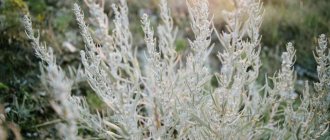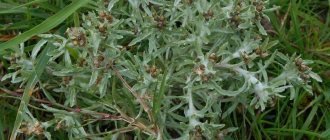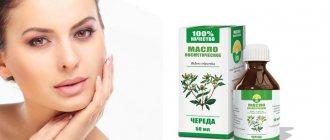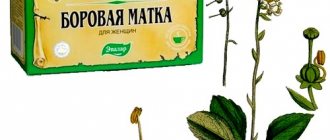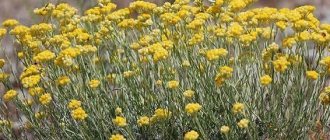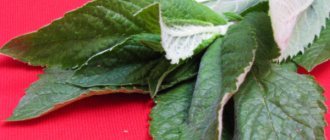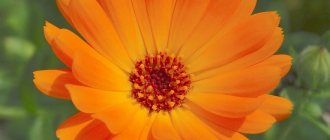Wormwood was once very popular, especially among artists, who chose absinthe, an alcohol containing wormwood, anise and fennel, as their favorite drink. Many people today associate wormwood exclusively with absinthe, but this herb has much more benefits than serving only as a raw material for alcohol. And I must say, our great-grandmothers knew about this.
general characteristics
Wormwood, or Chernobyl, is distributed throughout Europe, North America, Western Asia and North Africa. This plant from the Asteraceae family can often be seen on sunny hills, wastelands, forest glades, and mountain slopes. Chernobyl is a tall perennial with a straight, branched stem covered with fluff and silvery leaves. This herb blooms with yellow flowers, collected at the top of the stems in small, discreet baskets. During the flowering period, the plant secretes a resin that protects it from insects.
Content:
- general characteristics
- Chemical composition
- Benefits for humans
- Wormwood in folk medicine
- Natural medicines from Chernobyl
- Use in the food industry
- How to properly collect and prepare
- Possible side effects
Wormwood was known as a medicinal plant in ancient Babylon and Assyria, and the father of medicine, Hippocrates, mentions it in his works as a potion for jaundice and stomach diseases. In Algeria, an alcoholic infusion of wormwood is taken as a medicine against malaria. This plant is also known as a universal remedy against pests. Interestingly, in ancient times, wormwood juice was added to ink to repel mice from books. To drive moths away from various fabrics, they were also sprinkled with grass juice. And bouquets of this plant placed indoors will help get rid of flies. Interestingly, pets can also experience the benefits of wormwood. If cats or dogs are bothered by fleas, it is enough to bathe the animals in a strong Chernobyl decoction. The same decoction can be used to disinfect animal wounds. And wormwood infusion will come to the aid of gardeners and gardeners when they need to get rid of annoying caterpillars.
In addition, in ancient times, people believed that this bitter plant protected against witchcraft. It was believed that wormwood growing in the garden drove away evil spirits from the house.
Botanical description
It grows from 50 to 200 cm, often as a subshrub, the pubescence is similar to silvery felt, the shoots are erect, the root is taprooted, branched. The stems are straight, almost smooth, branch upward, often with short, sterile shoots located at the base.
At the bottom of the plant there are leaves with long petioles, dissected two or three times, in the middle of the plant the leaves have short petioles, dissected twice, at the top of the wormwood leaves are almost sessile, pinnate or dissected twice, parts of all leaves are pointed. All flowers are tubular in structure, yellow in color, the outer ones are pistillate, and in the middle are bisexual. The baskets are balls, 2.5–3.5 mm in diameter, located on short branches in one-sided tassels, which create a narrow panicle-shaped inflorescence.
The baskets are wrapped in imbricated skin, the leaves have a wide film. A convex receptacle with hairs predominates. Wormwood blooms in June–July on the European territory of Russia. The fruits grow in the form of sharp brownish seeds, approximately 1 mm long, oblong in shape, similar to wedges, with thin grooves, with a round, slightly convex area at the top. Fruit ripening occurs in August–September. Reproduction occurs by seeds; wormwood tolerates frost and dry weather well.
Chemical composition
There are many varieties of wormwood and not all of them have healing properties. In addition, some varieties are difficult to distinguish from each other. In herbal medicine, branches, leaves and flowers of herbs rich in chemical components are used. Wormwood leaves, for example, contain glycosides, essential oil, flavonoids, tannins, organic acids, and vitamin C.
Recent studies have indicated the presence of specific compounds in wormwood leaves, which actually give the plant a bitter taste. In addition, it turned out that these substances also have antispasmodic and antiseptic properties. Other components found in wormwood include flavonoids, tannins and minerals; in particular, the plant contains a lot of potassium.
No less beneficial for humans is wormwood oil, which is obtained by steam distillation from the leaves and flowers of the herb. Chernobyl essential oil contains 28 active ingredients, and they make up 93% of the total chemical composition of the substance. But among the chemical elements in wormwood there is also a dangerous thujone, which, however, is removed from the plant during the alcohol production process.
Features of the plant
Wormwood can reach 2m.
The plant is tall, can reach 2 m. Distributed everywhere.
It can be found in cultivated areas and wastelands.
The poisonous properties of wormwood make it inedible for animals. Even the surrounding plants of other species grow poorly.
Today there are more than 400 species of wormwood. 170 of them grow in Russia and Ukraine.
Externally, individual varieties differ in the shape and color of the leaves. The most common are wormwood: citvar, silver, Crimean (Tauride), lemon, God's tree (tree), common (Chernobyl), sea, Austrian, amber and, of course, bitter.
Unpretentiousness and resistance to negative factors make the plant very tenacious. It grows easily in wastelands, and when settling on cultivated lands, it is difficult to remove. After all, wormwood is resistant to any negative influences and spreads easily.
Benefits for humans
Wormwood has an antibacterial effect, cleanses the kidneys, relieves fever, activates metabolic processes, stimulates appetite, improves digestion, and has a beneficial effect on the urinary and bile ducts.
One of the most well-known benefits of this herb is its ability to eliminate parasites, including intestinal parasites. In addition, wormwood contains a substance known as artemisinin, which has antimalarial activity. And this is not all the beneficial properties of the plant. Research indicates that mugwort can inhibit the development of cancer cells and is also a useful remedy for anorexia, anemia, bloating and indigestion. Chernobyl has been known since ancient times as a medicine for digestive disorders and flatulence. In addition, the bitter taste of the herb promotes better production of bile and gastric juice, and wormwood tea has the properties of an energy drink.
Now let's talk about the scientifically proven properties of wormwood.
Treats malaria
Malaria is a serious disease caused by parasites. Infection occurs through the bite of an infected mosquito. Artemisinin, contained in wormwood, is a powerful antimalarial agent. Once in the infected body, this substance promotes recovery. WHO recommends wormwood-based preparations for people suffering from various forms of malaria.
Artemisinin, among other things, has antioxidant properties that remove free radicals from the body. And this is also an additional advantage in antimalarial therapy.
Has anti-cancer properties
According to recent studies, thanks to the already mentioned artemisinin, wormwood reduces the risk of the formation of malignant tumors and inhibits their growth. The effectiveness of the plant has been laboratory proven using the example of breast cancer cells. It is also interesting that while consuming Chernobyl, healthy cells do not experience any changes, but tumor cells die within 16 hours.
Removes parasites from the body
Wormwood is one of the most famous substances for removing endoparasites, in particular roundworms and pinworms. Pinworms are one of the most common parasites in the world and are very easily transmitted. Nematodes and worms are less common, but they are more dangerous to health. Tapeworm infections include severe itching, cough, shortness of breath, abdominal pain, diarrhea, nausea, blood in the stool, and weight loss despite proper nutrition. Parasites are found in most animals and are sometimes transmitted to humans. Fortunately, modern pharmacology offers many options for treating parasites. But this does not mean that “chemistry” is the only panacea. Before resorting to the help of the chemical industry, you can try the method that our great-grandmothers used. We are talking about wormwood extract. Perhaps the most effective folk remedy for parasites is to consume a mixture of black walnut, cloves and wormwood. And it must be said that the effectiveness of such a medicine has also been confirmed in scientific laboratories.
Helps treat Crohn's disease
Scientific research indicates that consuming mugwort extract three times daily may help reduce symptoms of this disease. A positive effect was recorded in 90% of patients participating in the experiment. But it should be said that these are only the first preliminary studies. But the effect of Chernobyl on an organism suffering from autoimmune diseases has already impressed scientists. Researchers continue to discover new properties of this herb.
Has antibacterial and antifungal effects
Laboratory studies confirm that wormwood essential oil has a strong effect on bacteria, viruses and fungi. Its action is so powerful that it destroys even virulent bacteria such as E. coli and salmonella. By the way, several million people worldwide become victims of salmonella every year, children and the elderly are especially vulnerable. The bacterium E. coli is the cause of many diseases. It can cause diarrhea, infectious diseases of the genitourinary system, respiratory tract diseases and others. Wormwood helps maintain a healthy digestive system by destroying bacteria.
The effectiveness of the herbal extract was also determined against fungi. The most effective is wormwood essential oil, which also has antioxidant properties. Research indicates that the essential oil of this plant inhibits the growth of Candida fungi. And this is very important, since candidiasis has become a worldwide problem in recent years. These fungi can attack the entire body - the oral cavity, intestines, and reproductive system. But by consuming wormwood, you can get rid of the disease.
Protects the small intestine
Studies have shown that wormwood restores the natural intestinal microflora. It is known that the use of antibiotics has a bad effect on the state of the intestinal microflora. Scientists, comparing the effectiveness of antibiotics and herbal medicines, have come to some interesting conclusions. It turned out that herbs such as wormwood, oregano, thyme are effective in the treatment of intestinal diseases. The positive effect of herbal treatment was felt by 46% of the participants in the experiment. In addition, herbs, compared to antibiotics, do not cause dysbiosis and do not affect the functioning of the digestive tract. According to scientists, treatment with these herbs is almost as effective as using pharmaceutical medications.
Medicinal properties of wormwood
Traditionally, wormwood has always had pharmaceutical and botanical significance and has been used to treat a number of diseases, including hepatocyte enlargement, hepatitis, gastritis, jaundice, wound healing, splenomegaly, dyspepsia, indigestion, flatulence, stomach pain, anemia and anorexia. Mugwort has also been documented to have antioxidant, antifungal, antimicrobial, anthelmintic, antiulcer, anticancer, hepatoprotective, neuroprotective, antidepressant, analgesic, immunomodulatory, and cytotoxic activities. Combination chemotherapy of mugwort extract, or its isolated active components, with antimalarial drugs has been documented to help relieve malaria and piroplasmosis infections1.
Due to irritation of the nerve endings of taste buds in the oral cavity, the active components of wormwood stimulate the gastrointestinal glands (the production of bile and pancreatic juice increases). Wormwood essential oil acts on the central nervous system like camphor. Chamazulene activates the immune and excretory functions, which explains the laxative and anti-inflammatory effect of the plant.
Wormwood in folk medicine
This bitter plant has found use in folk medicine in many countries. For medicinal purposes, Chernobyl is collected from July to September. The raw materials are dried naturally in well-ventilated but dark places.
Once upon a time, crushed fresh wormwood leaves mixed with egg white were applied as a compress to bruises and wounds. Wormwood juice lotions were used to treat sore eyes. Herbalists treated stomach ailments and bad breath with Chernobyl infusions. The same medicine was given to people with any liver disease.
Infusions and tinctures from this herb were used to treat the stomach, drank in case of lack of appetite, chronic gastritis and intestinal diseases caused by decreased secretory activity of the stomach. In addition, wormwood was used to treat flatulence, intestinal colic, pancreatic dysfunction, and wormwood infusion was used to remove parasites, including lice and intestinal parasites.
Contraindications to the use of wormwood
But, despite such a huge number of beneficial properties, wormwood is far from harmless - there are significant contraindications to its use. As already mentioned, it should not be used by pregnant women. In addition, it is also dangerous during breastfeeding, with low acidity in the body, and with diseases of the intestines and stomach in acute forms. And of course, it should not be used by those who are allergic to wormwood. Even if there are none of the above restrictions, you still need to be very careful about how to drink wormwood. Too large doses, prolonged treatment, that is, uncontrolled use of wormwood can lead to convulsions, vomiting, fainting, nervous system disorders, and hallucinations. Therefore, it does not matter what exactly wormwood is used for - treatment should not be delayed for more than a month. It's better to take a break and then continue.
Natural medicines from Chernobyl
To improve appetite three times a day, half an hour before meals, it is useful to drink a teaspoon of wormwood wine. Medicinal wine is prepared from 3-5 tablespoons of chopped herbs and half a glass of 40% alcohol. The ingredients are mixed and left for 24 hours. Then add 1 liter of white wine and leave overnight. In the morning, strain and can be consumed.
Wormwood tincture retains all the healing properties of the herb. But most often this medicine is used for diseases of the digestive system. In particular, with diarrhea, abdominal pain, indigestion. Prepare the tincture as follows. Fill the bottle with young leaves of grass and add alcohol. Leave in a warm place for a week, then strain. The strength of the finished tincture can be reduced by adding water to it. For severe diarrhea, take this medicine one tablespoon every 3 hours. In other cases, it is enough to consume 1 tablespoon per day.
And here is another popular recipe for Chernobyl tincture, which herbalists advise drinking a tablespoon 2-3 times a day to cleanse the blood and for stomach upsets. In a vessel put 3 dry branches of wormwood, 5 St. John's wort inflorescences with leaves, 1 geranium leaf, 8 black pepper grains, 10 raisins, 10 g of green tea, 1 tablespoon of honey and a liter of vodka. Close the vessel, wrap it in cloth and place in a pan of hot water for 2 hours. Then the mixture is infused for a week, after which it is filtered through several layers of gauze.
Wormwood for beauty preservation
In addition to getting rid of diseases, wormwood also helps preserve beauty.
If you have oily hair, you can wash your hair with wormwood infusion: pour a glass of fresh chopped herbs into 2.5 liters of boiling water and leave for half an hour.
The following recipes will help slow down skin aging:
- 250 gr. dry wormwood, pour two liters of boiling water. Let it brew for half an hour. Pour the strained infusion into the bath. Take it for 20 minutes one hour before bedtime.
- Fill 2/3 of a half-liter bottle with sunflower seeds. Add 2 tablespoons of vinegar and 4 tablespoons of chopped wormwood. Close the bottle and place in a bright place. Leave for two weeks, shaking the contents daily. Then strain. This oil is good for massage. By the way, it will also help against cellulite.
Use in the food industry
Even in Ancient Egypt, wormwood was added as a seasoning to food, or rather to alcohol. Mainly for wines. The tradition of using Chernobyl in the preparation of alcoholic beverages continued in France in the 19th century. At that time, absinthe was popular, especially among bohemians. However, in those days, absinthe contained a lot of the toxic substance thujone, which has a detrimental effect on the central nervous system and causes addiction. Today, absinthe is safer.
Sometimes wormwood is added as a herb to fatty meat dishes, including goose, duck or lamb. It is believed that a small amount of this herb improves the taste of the finished dish. Fresh leaves are also added to some cocktails. In Morocco, for example, a small piece of Chernobyl leaf is traditionally added to a mixture of mint and green tea. This drink leaves an unusual bitter aftertaste. But in this matter, the main thing is not to overdo it, otherwise the tea will become very bitter and have an unpleasant odor. Surprisingly, the bitter taste of wormwood tea remains even if it is diluted in a ratio of 1:800. But it was precisely because of its bitterness that this herb in microdoses was once so often added to various sauces. Today, wormwood is used primarily for the preparation of bitters, vermouths, liqueurs, and flavored vodka.
Another use of wormwood
There is another use for wormwood that has not been mentioned. Its essential oil is used to make an alcoholic drink such as absinthe. By the way, translated from French the word “absinthe” means “wormwood”. This drink is very, very strong - 70 degrees. Its history is as old as wormwood itself. At one time they were also offered treatment. And very quickly this drink gained popularity. But intoxication with absinthe is different from intoxication with regular alcohol. It is closer to the intoxication of marijuana. And if absinthe is useful in small quantities, then in large doses it can cause nervous disorders. That's why it is banned in many countries. But the famous “Riga Balsam”, which also contains wormwood, is still sold and loved by many.
Back | All news
How to properly collect and prepare
Best materials of the month
- Coronaviruses: SARS-CoV-2 (COVID-19)
- Antibiotics for the prevention and treatment of COVID-19: how effective are they?
- The most common "office" diseases
- Does vodka kill coronavirus?
- How to stay alive on our roads?
Dried wormwood either does not contain thujone at all or is present in negligible quantities, which makes the dry plant safe for consumption. A medicinal infusion of Chernobyl is prepared from half a teaspoon of dry herbs and a glass of boiling water, the mixture is infused for 15 minutes. You can give a little more herb, but in this case the result is a very bitter infusion that is impossible to drink. The same applies to drinks aged for more than 15 minutes.
But no matter how bitter wormwood tea is, it is undesirable to add sweeteners to it, since sugar affects the medicinal properties of the herb. You can minimize the bitter taste by adding mint and anise to your tea. Wormwood is drunk in small sips.
